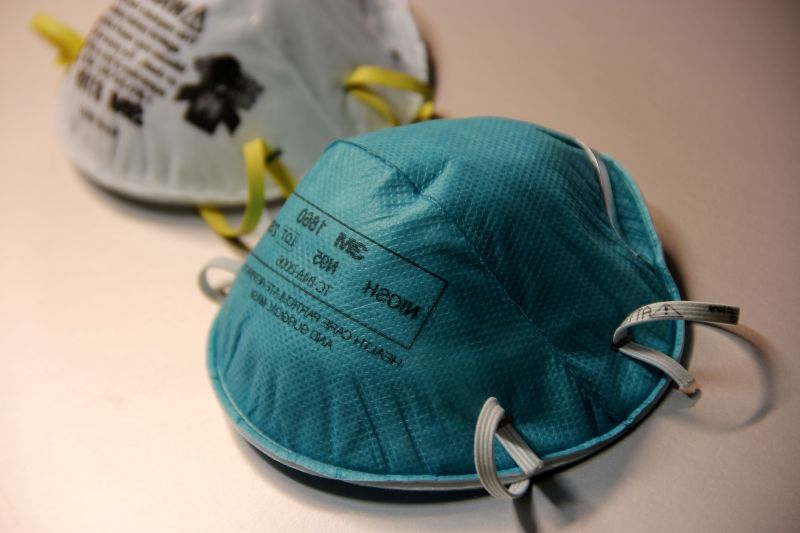A team of Stanford researchers may have found a way to use heat to disinfect N95 respirators, potentially enabling reuse of the single-use masks that are running dangerously low nationwide as the number of COVID-19 cases in the U.S. continues to grow.
The team’s research, based on experiments on a type of fabric commonly used in respirators and industrial-grade respirators, found that a 30-minute exposure to 75 °C could be used up to 20 times to disinfect N95 respirators without a loss of filtration efficiency and mechanical deformation.
These findings could be game-changing for both hospitals and individuals due to the method’s ease of use, said materials science and engineering professor Yi Cui, who led the research at 4C Air along with physics and molecular biology professor Steven Chu.
“It’s easy to generate heat with a reasonable uniformity, whether it’s in a convection oven or something else,” Cui said.
People across the country rely on N95 respirators — which filter out 95% of incoming particles, including viruses and bacteria — to protect themselves from potential infection. As the number of cases in the U.S. surpasses 160,000, the most in any country, medical workers nationwide are reporting dire shortages of these and other personal protective equipment (PPE).
Stanford Hospital currently has sufficient PPE, according to Stanford Health Care Vice President of Supply Chain Amanda Chawla, although some doctors have reported otherwise.
Alexei Wagner, an emergency medicine physician at Stanford Hospital, told NBC that “we are definitely running low on some of the most important personal protective equipment, particularly N95 respirator masks.”
Due to liability concerns, however, Cui said he would not make any recommendations about whether or not hospitals or individuals should adopt the disinfection methods his team tested, but he wanted the data to be available so that people could draw their own conclusions.
The Food and Drug Administration (FDA) approved on Monday a decontamination process for respirators that uses vaporized hydrogen peroxide. Cui said that while the process could work on an industrial level, he is concerned that individuals with less access to hydrogen peroxide monitoring systems will have difficulty accurately disinfecting the respirators.
“On the industry scale, you can control [hydrogen peroxide] concentrations much more,” he said. “For individual persons or individual players not equipped with hydrogen peroxide monitoring, using heat is so attractive because it can be a lot more uniform and a lot more controllable.”
While the 4C Air team tested disinfection with E. Coli, Cui said there is a “high possibility” that the method would eradicate COVID-19 as well, explaining that 30 minutes of exposure to 60 °C heat is sufficient to eradicate SARS-CoV-1, the human coronavirus that most closely resembles COVID-19.
He caveated that the blue, medical-grade N95 respirators differ from the white, industrial-grade N95 that his team has used in its tests due to a bodily fluid protection layer in the medical-grade respirators that could affect whether they can be disinfected for reuse. For instance, Cui said heat disinfection could damage a respirator if its fluid protection layer is made up of a polymer with a lower melting point than the rest of the respirator.
Cui said the team’s next steps would be finding partners to do virus testing, ideally with COVID-19 samples. In addition to providing frequent updates on its research to Stanford Medicine, the team also hopes to fast-track its study to publication in the coming weeks.
“Be mindful that this report is our work in progress, including some of our speculation,” the team wrote in the introduction to the paper it released on Wednesday. “We will have more results in the coming days and weeks.”
4C Air gets to work
At the start of the outbreak, 4C Air, which previously used its lab to research nanotechnology to create innovative air filters, pivoted from creating respirators that passed China’s KN95 certification to trying to ship respirators back from China to the United States, according to Cui. However, he soon concluded that given the scope of the pandemic, efforts to increase the number of respirators and masks in the U.S. would not be enough.
“Now, the question is can we reuse the same masks,” he said. “The virus outbreak changed everything. No one thought the United States would run out of masks, and we don’t have enough here.”
The team at 4C Air began looking into methods to decontaminate respirators, focusing on techniques that could be easily implemented by hospitals and even individual households.
The researchers first tested applying alcohol and chlorine to meltblown fabric, which is used in respirators, and found that the substances greatly reduced the filtration efficiency of the fabric. They then tested steam, UV light in a sterilizing cabinet and hot air in an oven. They found that while the fabric could survive a few cycles with steam and UV disinfection, repeated disinfection also reduced its filtration efficiency.
Cui said he is especially worried that people attempting to disinfect respirators with UV light at home could miss spots: Respirators are 3D, resulting in different amounts of UV exposure to different parts, and the penetration depth of UV light is limited.
Disinfection with 30-minute exposure to 75 °C heat in an oven was the only method of the five that resulted in maintained filtration efficiencies over 20 cycles of disinfection.
Cui said his team was also considering looking into microwave disinfection, though he added that it is more difficult to calibrate heat in a microwave and that the presence of metal in some respirators could throw sparks.
Following guidelines from the University to reduce on-campus, in-person research, Cui said the team has conducted its research off campus at the 4C Air labs.
“Having a few people working in a Stanford lab would have helped in speeding up the whole process for sure,” he said. “But I’m already fortunate to have the 4C Air team and the company. I feel lucky to have several people running shifts and maintaining social distance.”
